Geometrical Parameter Effects on Solidification/Melting Processes Using Twin Concentric Helical Coil: Experimental Investigations
Abstract
:1. Introduction
2. Experimental Setup and Procedures
Data Reduction
3. Results and Discussion
3.1. Effect of Coil Pitch
3.2. Effect of Tube Diameter
4. Conclusions
Author Contributions
Funding
Conflicts of Interest
Nomenclature
| Ice specific heat | J/kg.°C | |
| Water specific heat | J/kg.°C | |
| Test tube outer diameter | m | |
| Water latent heat of fusion | J/kg | |
| Distilled water melted mass | kg | |
| PCM total stored mass in the tank | ||
| Solidified mass of the PCM | kg | |
| kg | ||
| N | Number of coil turns | - |
| p | Pitch of the TCHC | - |
| - | ||
| m | ||
| Accumulative thermal energy regained | W | |
| Max thermal energy regained | W | |
| Accumulative thermal energy regained difference | J | |
| J | ||
| Accumulative thermal energy stored | J | |
| Max thermal energy stored | J | |
| Accumulative thermal energy stored difference | J | |
| Coil centerline radius | m | |
| Coil inner radius | m | |
| Coil outer radius | m | |
| Radius of the solid–liquid interface at the left side of the inner coil of TCHC | m | |
| Radius of the solid–liquid interface at the right side of the inner coil of TCHC | m | |
| Radius of the solid–liquid interface on the left side of the outer coil of TCHC | m | |
| Solid–liquid interface radius | m | |
| The right side of the outer coil of TCHC | ||
| Outer radius of the test tube | m | |
| Solid–liquid average thicknessInterface around the TCHC | m | |
| °C | ||
| Heat transfer fluid temperature | °C | |
| Liquid phase temperature | °C | |
| Initial temperature | °C | |
| Phase change temperature | °C | |
| Solid phase temperature | °C | |
| PCM melted volume | m3 | |
| Stored PCM total volume | m3 | |
| Solidified volume of the PCM | m3 | |
| Time interval | s | |
| Greek symbols | ||
| Ice density | kg/m3 | |
| Water density | kg/m3 | |
| Volume correction factor | - | |
| Time | s | |
| Abbreviations | ||
| CTES | Cool thermal energy storage | |
| DTC | Digital temperature controller | |
| HTF | Heat transfer fluid | |
| L/min | Liter/min | |
| PCM | Phase change material | |
| TCHC | Twin concentric helical coil | |
References
- Habeebullah, B.A. An experimental study on ice formation around horizontal long tubes. Int. J. Refrig. 2007, 30, 789–797. [Google Scholar] [CrossRef]
- Sait, H.; Selim, A. Charging and discharging characteristics of cool thermal energy storage system with horizontal pipes using water as phase change material. Energy Convers. Manag. 2014, 77, 755–762. [Google Scholar] [CrossRef]
- Fanga, Y.; Xub, H.; Miaob, Y.; Baib, Z.; Niua, J.; Deng, S. Experimental study of storage capacity and discharging rate of latent heat thermal energy storage units. Appl. Energy 2020, 275, 115325. [Google Scholar] [CrossRef]
- López-Navarro, A.; Biosca-Taronger, J.; Torregrosa-Jaime, B.; Corberán, J.M.; Bote-García, J.L.; Payá, J. Experimental investi-gations on the influence of ice floating in an internal melt ice-on-coil tank. Energy Build. 2013, 57, 20–25. [Google Scholar] [CrossRef] [Green Version]
- Sait, H.H. Experimental study of water solidification phenomenon for ice-on-coil thermal energy storage application utilizing falling film. Appl. Therm. Eng. 2018, 146, 135–145. [Google Scholar] [CrossRef]
- Xie, J.; Yuan, C. Parametric study of ice thermal storage system with thin layer ring by Taguchi method. Appl. Therm. Eng. 2016, 98, 246–255. [Google Scholar] [CrossRef] [Green Version]
- Bai, Q.; Guo, Z.; Cui, X.; Yang, X.; Yanhua, L.; Jin, L.; Sun, Y. Experimental investigation on the solidification rate of water in open-cell metal foam with copper fins. Energy Procedia 2018, 152, 210–214. [Google Scholar] [CrossRef]
- Jannesari, H.; Abdollahi, N. Experimental and numerical study of thin ring and annular fin effects on improving the ice formation in ice-on-coil thermal storage systems. Appl. Energy 2017, 189, 369–384. [Google Scholar] [CrossRef]
- Gasia, J.; de Gracia, A.; Zsembinszki, G.; Cabeza, L.F. Influence of the storage period between charge and discharge in a latent heat thermal energy storage system working under partial load operating conditions. Appl. Energy 2018, 235, 1389–1399. [Google Scholar] [CrossRef]
- Ezan, A.; Erek, M.A. Solidification and Melting Periods of an Ice-on-Coil Latent Heat Thermal Energy Storage System. ASME. J. Heat Transfer. 2012, 134, 062301. [Google Scholar] [CrossRef]
- ElGhnam, R.I.; Abdelaziz, R.A.; Sakr, M.H.; Abdelrhman, H.E. An experimental study of freezing and melting of water inside spherical capsules used in thermal energy storage systems. Ain Shams Eng. J. 2012, 3, 33–48. [Google Scholar] [CrossRef] [Green Version]
- Prabakaran, R.; Kumar, J.P.N.; Lal, D.M.; Selvam, C.; Harish, S. Constrained melting of graphene-based phase change nanocomposites inside a sphere. J. Therm. Anal. 2019, 139, 941–952. [Google Scholar] [CrossRef]
- Li, Y.; Yan, Z.; Yang, C.; Guo, B.; Yuan, H.; Zhao, J.; Mei, N. Study of a Coil Heat Exchanger with an Ice Storage System. Energies 2017, 10, 1982. [Google Scholar] [CrossRef] [Green Version]
- Mahdi, M.S.; Mahood, H.B.; Campbell, A.N.; Khadom, A.A. Experimental study on the melting behavior of a phase change material in a conical coil latent heat thermal energy storage unit. Appl. Therm. Eng. 2019, 175, 114684. [Google Scholar] [CrossRef]
- Naphon, P. Thermal performance and pressure drop of the helical-coil heat exchangers with and without helically crimped fins. Int. Commun. Heat Mass Transf. 2007, 34, 321–330. [Google Scholar] [CrossRef]
- Abdelrahman, H.; Refaey, H.; Alotaibi, A.; Abdel-Aziz, A.A.A.; Rabbo, M.A. Experimental investigations on the thermal performance of an ice storage system using twin concentric helical coil. Appl. Therm. Eng. 2020, 179, 115737. [Google Scholar] [CrossRef]
- Hamzeh, H.A.; Miansari, M. Numerical study of tube arrangement and fin effects on improving the ice formation in ice-on-coil thermal storage systems. Int. Commun. Heat Mass Transf. 2020, 113, 104520. [Google Scholar] [CrossRef]
- Sathishkumar, A.; Cheralathan, M. Charging and discharging processes of low capacity nano-PCM based cool thermal energy storage system: An experimental study. Energy 2023, 263, 125700. [Google Scholar] [CrossRef]
- Sidney, S.; Dhasan, M.L.; C., S.; Harish, S. Experimental Investigation of Freezing and Melting Characteristics of Graphene-Based Phase Change Nanocomposite for Cold Thermal Energy Storage Applications. Appl. Sci. 2019, 9, 1099. [Google Scholar] [CrossRef] [Green Version]
- Dogkas, G.; Koukou, M.K.; Konstantaras, J.; Pagkalos, C.; Lymperis, K.; Stathopoulos, V.; Coelho, L.; Rebola, A.; Vrachopoulos, M.G. Investigating the performance of a thermal energy storage unit with paraffin as phase change material, targeting buildings’ cooling needs: An experimental approach. Int. J. Thermofluids 2020, 3–4, 100027. [Google Scholar] [CrossRef]
- Al-Mudhafar, A.H.N.; Nowakowski, A.F.; Nicolleau, F.C. Performance enhancement of PCM latent heat thermal energy storage system utilizing a modified webbed tube heat exchanger. Energy Rep. 2020, 6, 76–85. [Google Scholar] [CrossRef]
- Mahdi, M.S.; Mahood, H.B.; Mahdi, J.M.; Khadom, A.A.; Campbell, A.N. Improved PCM melting in a thermal energy storage system of double-pipe helical-coil tube. Energy Convers. Manag. 2019, 203, 112238. [Google Scholar] [CrossRef]
- Incropera, F.P.; Dewitt, D.P. Fundamental of Heat and Mass Transfer, 4th ed.; John Wiley & Sons: New York, NY, USA, 1996. [Google Scholar]
- Moffat, R.J. Describing the uncertainties in experimental results. Exp. Therm. Fluid Sci. 1988, 1, 3–17. [Google Scholar] [CrossRef]


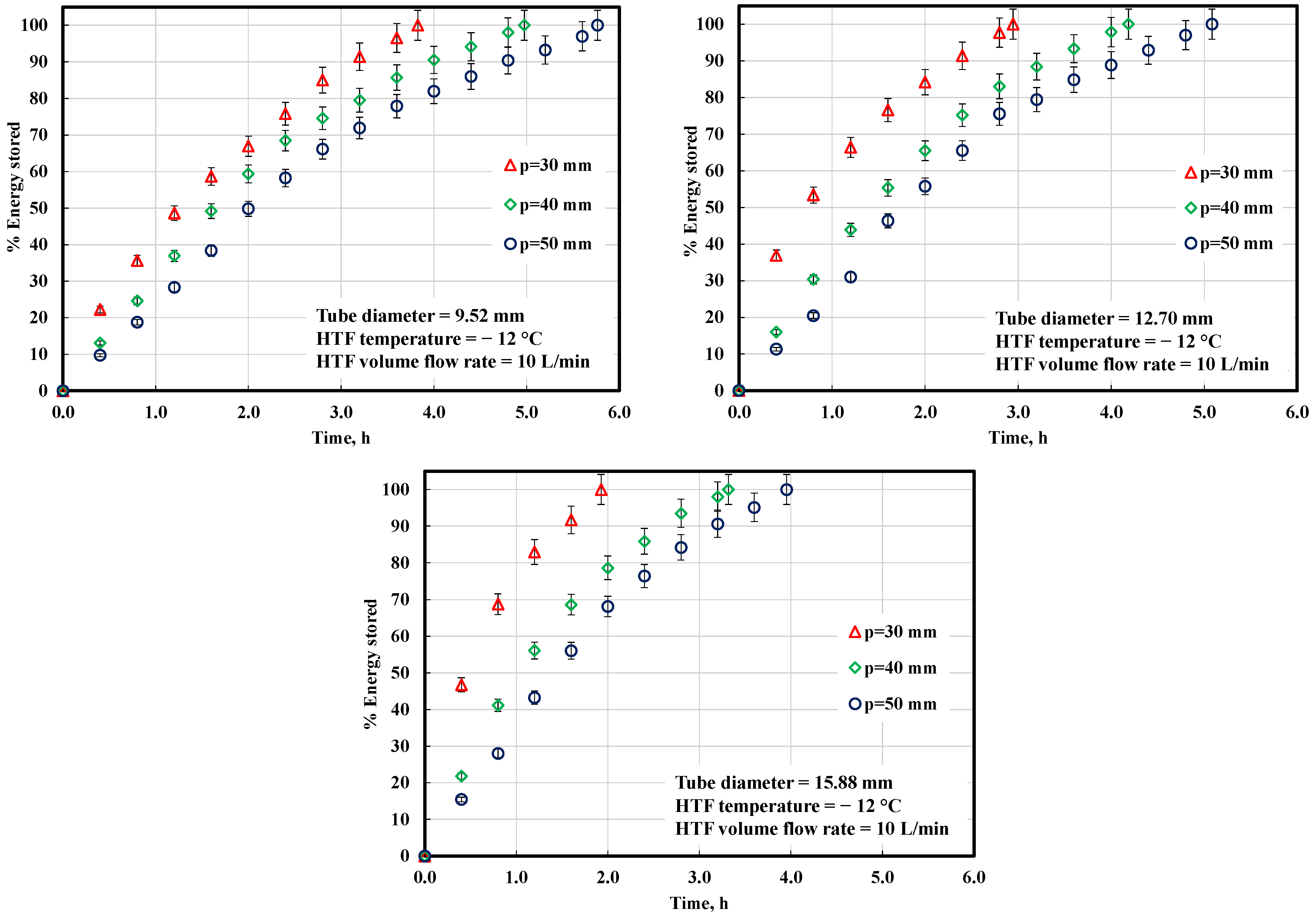
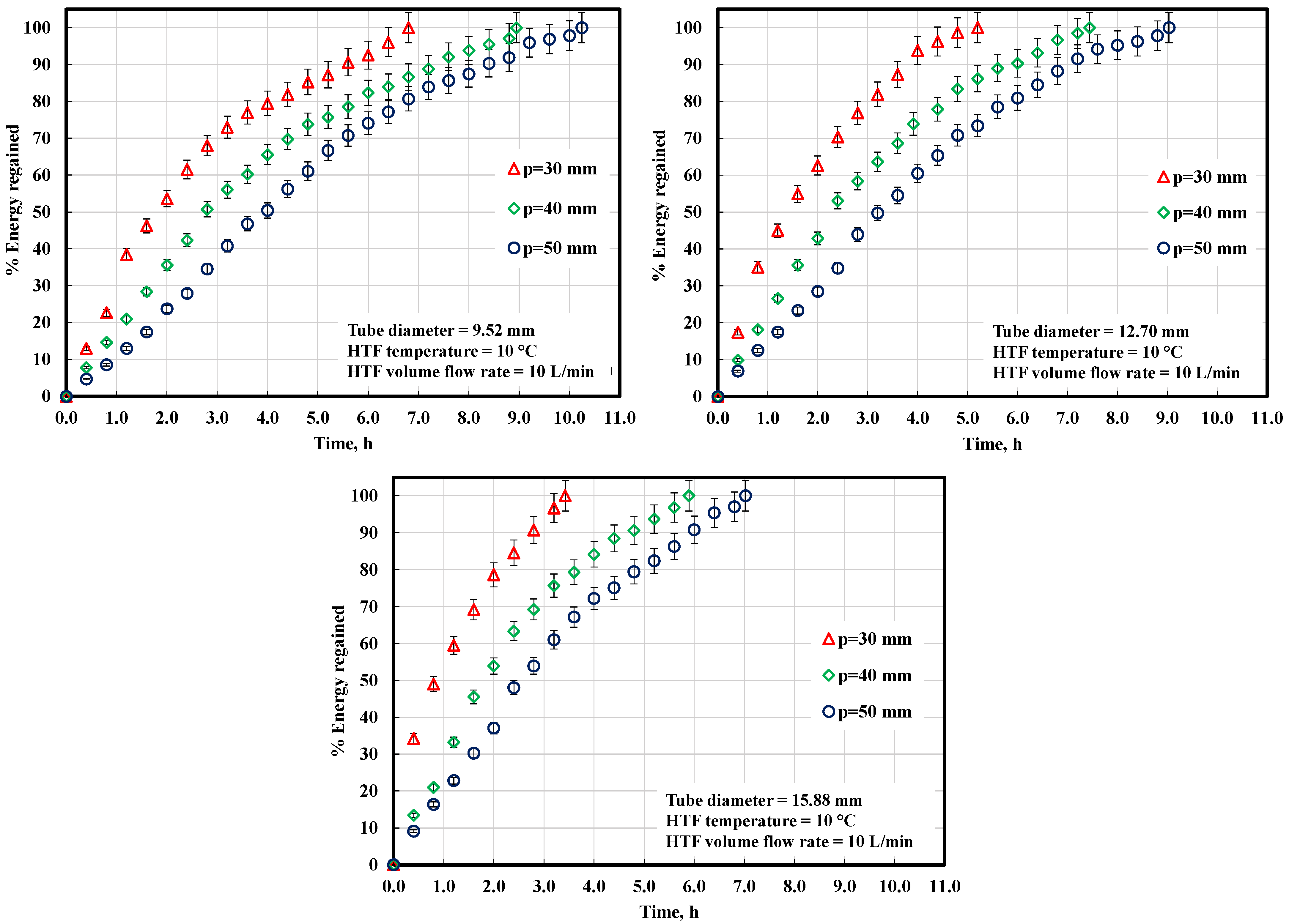
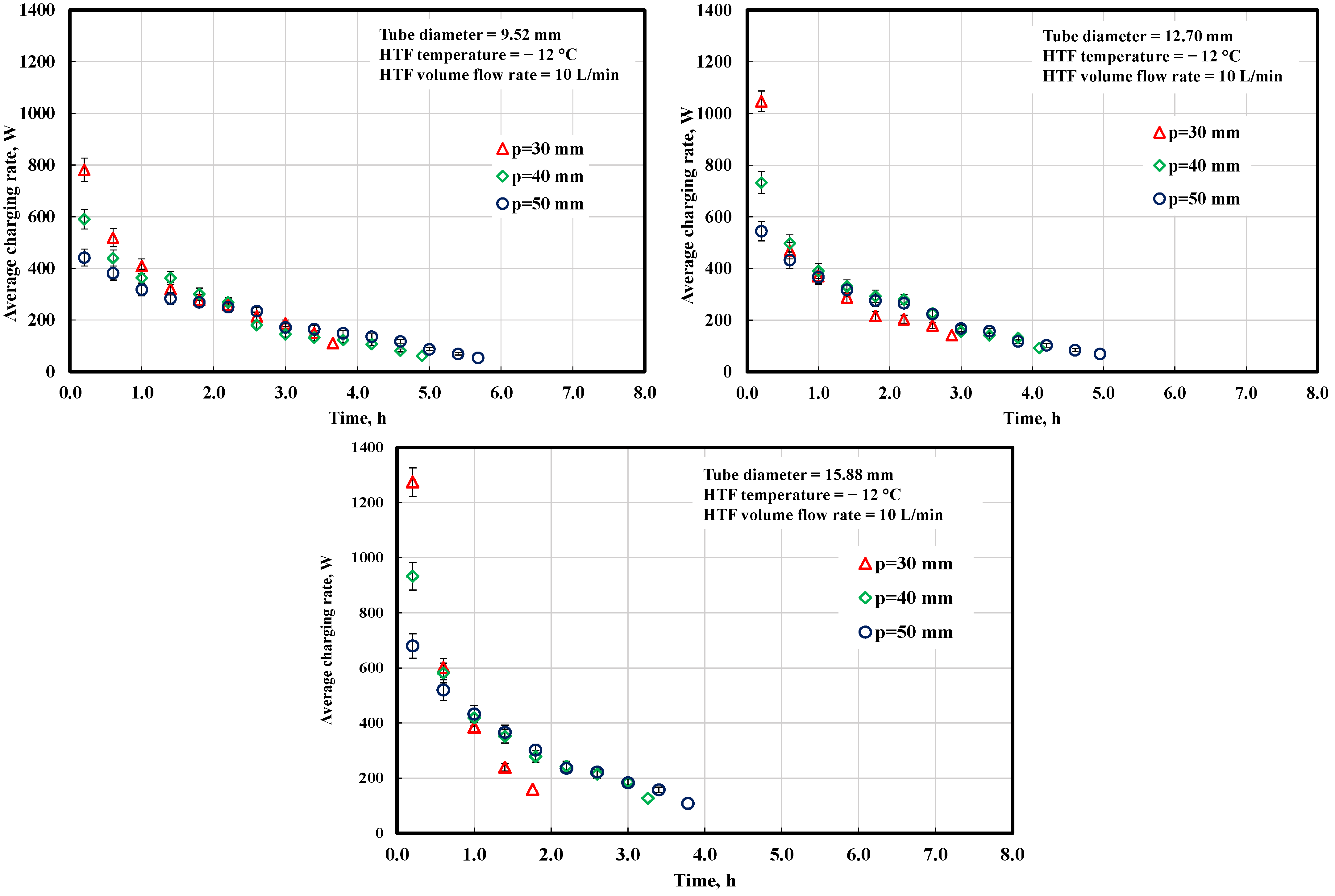

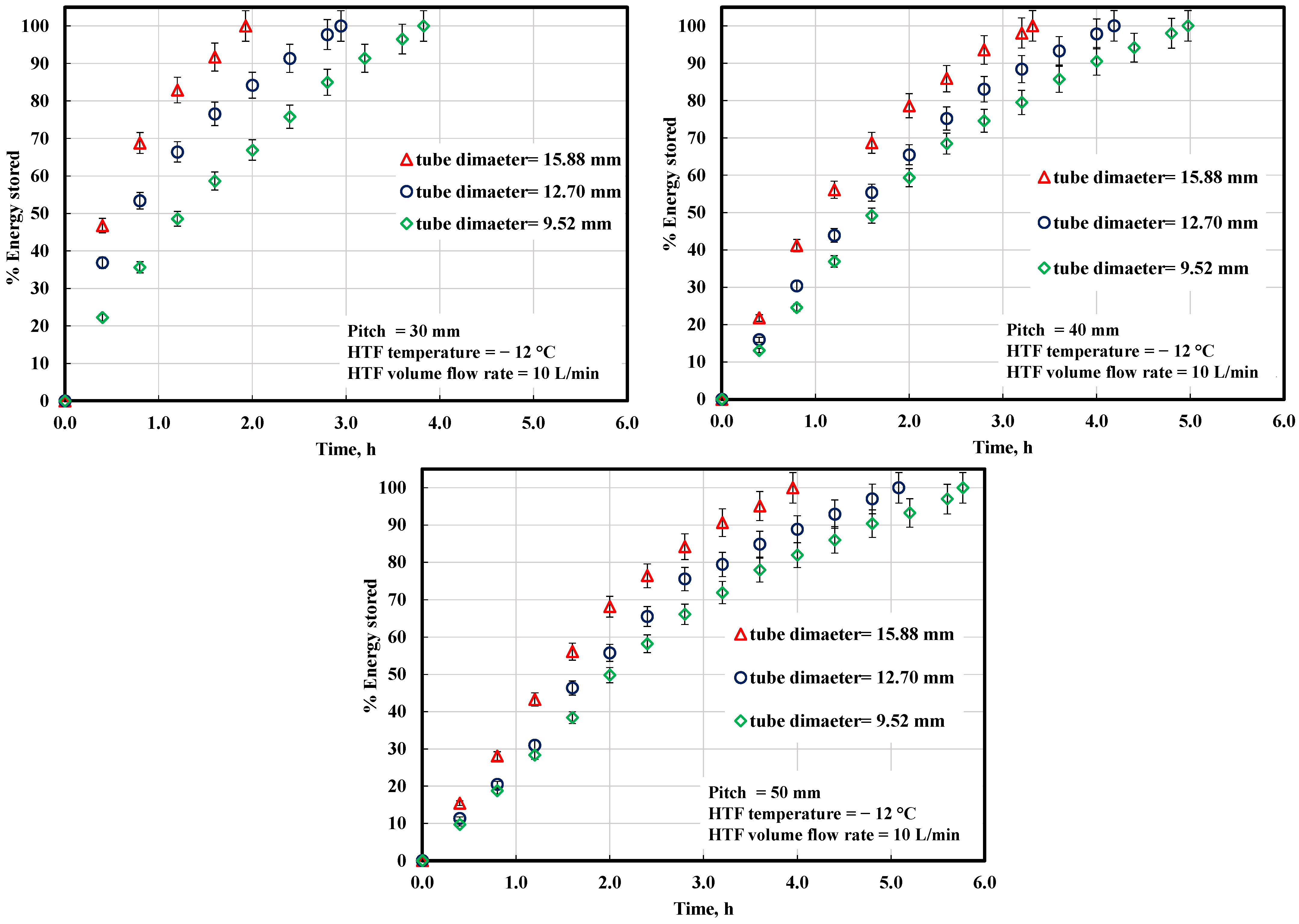
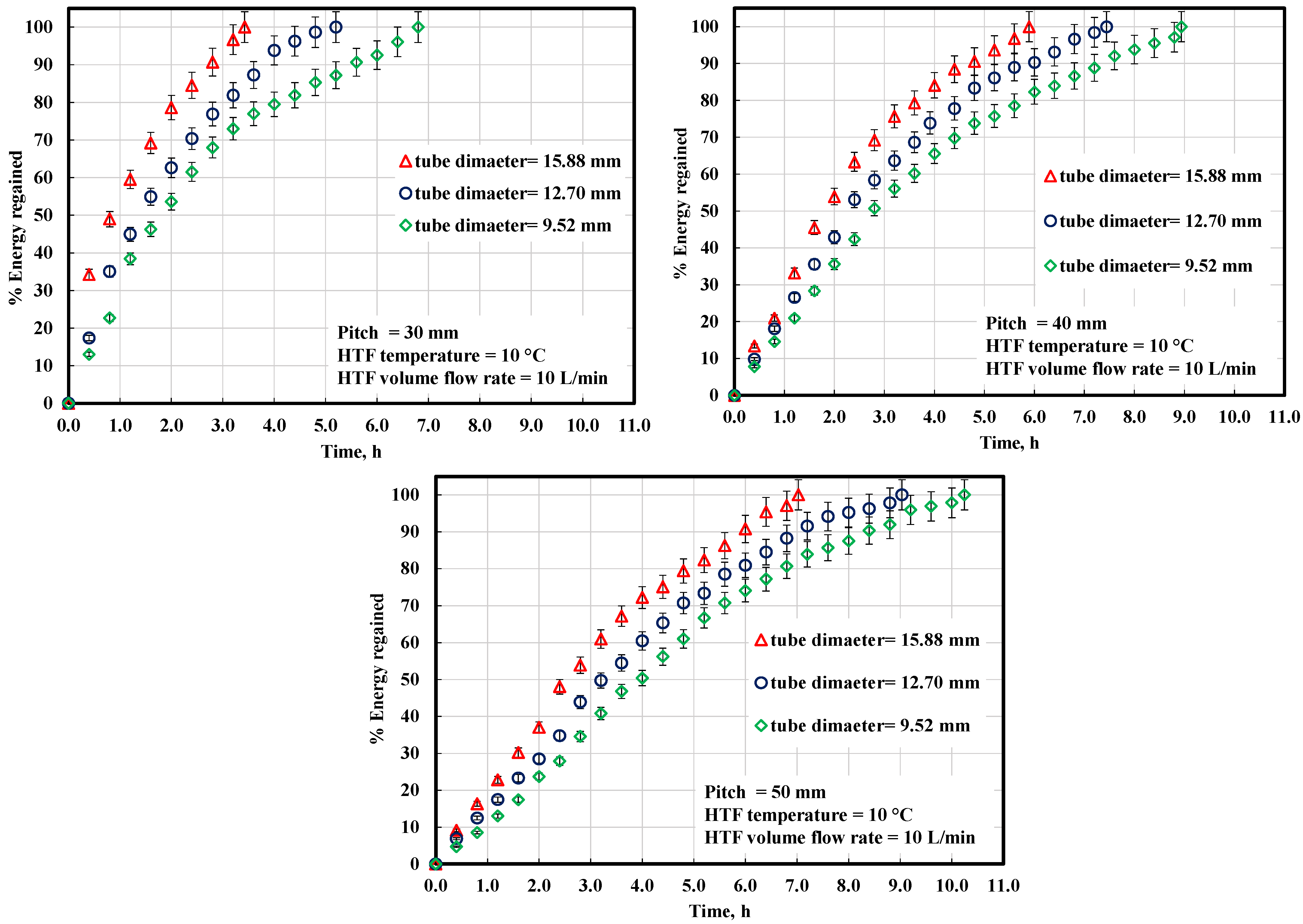
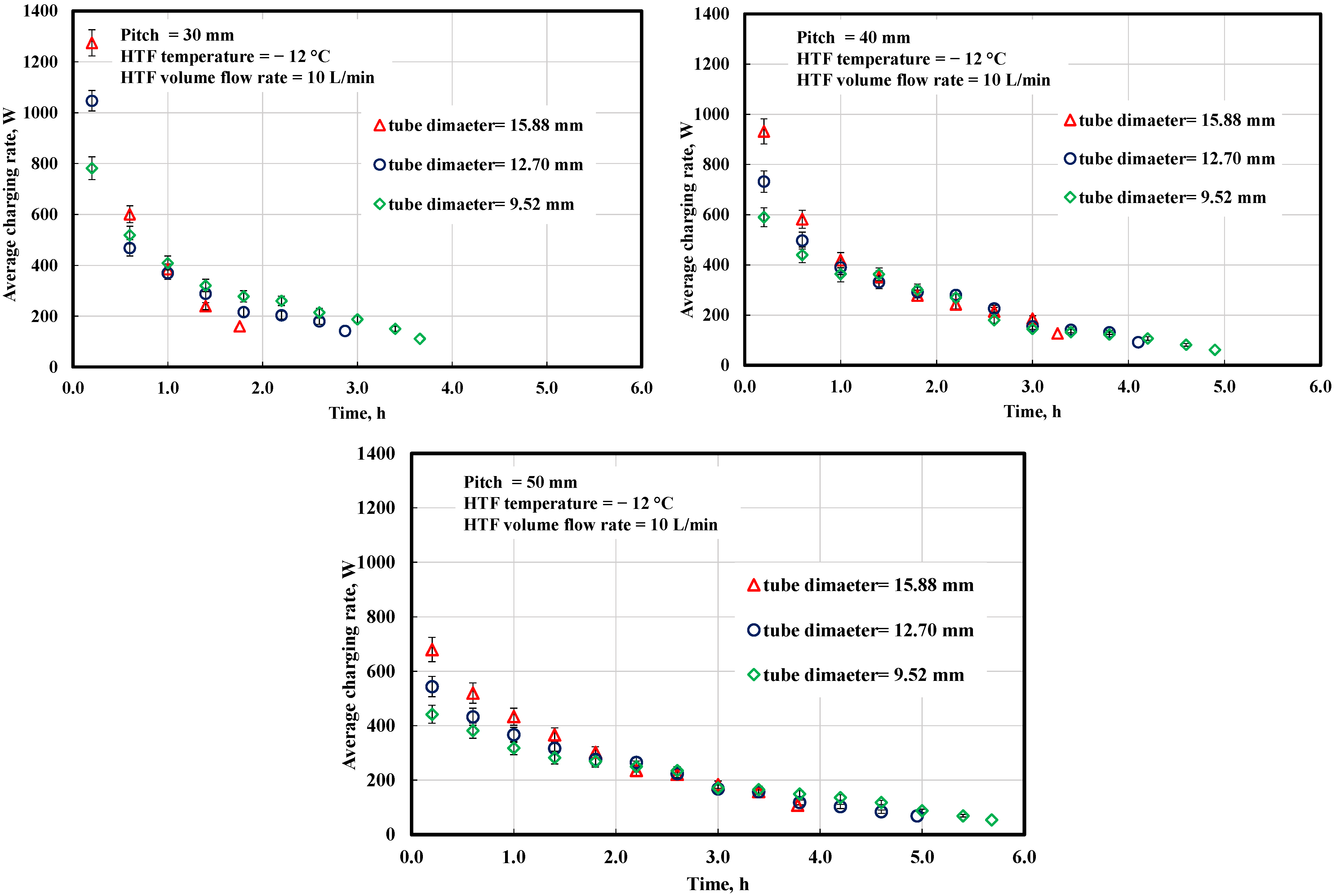
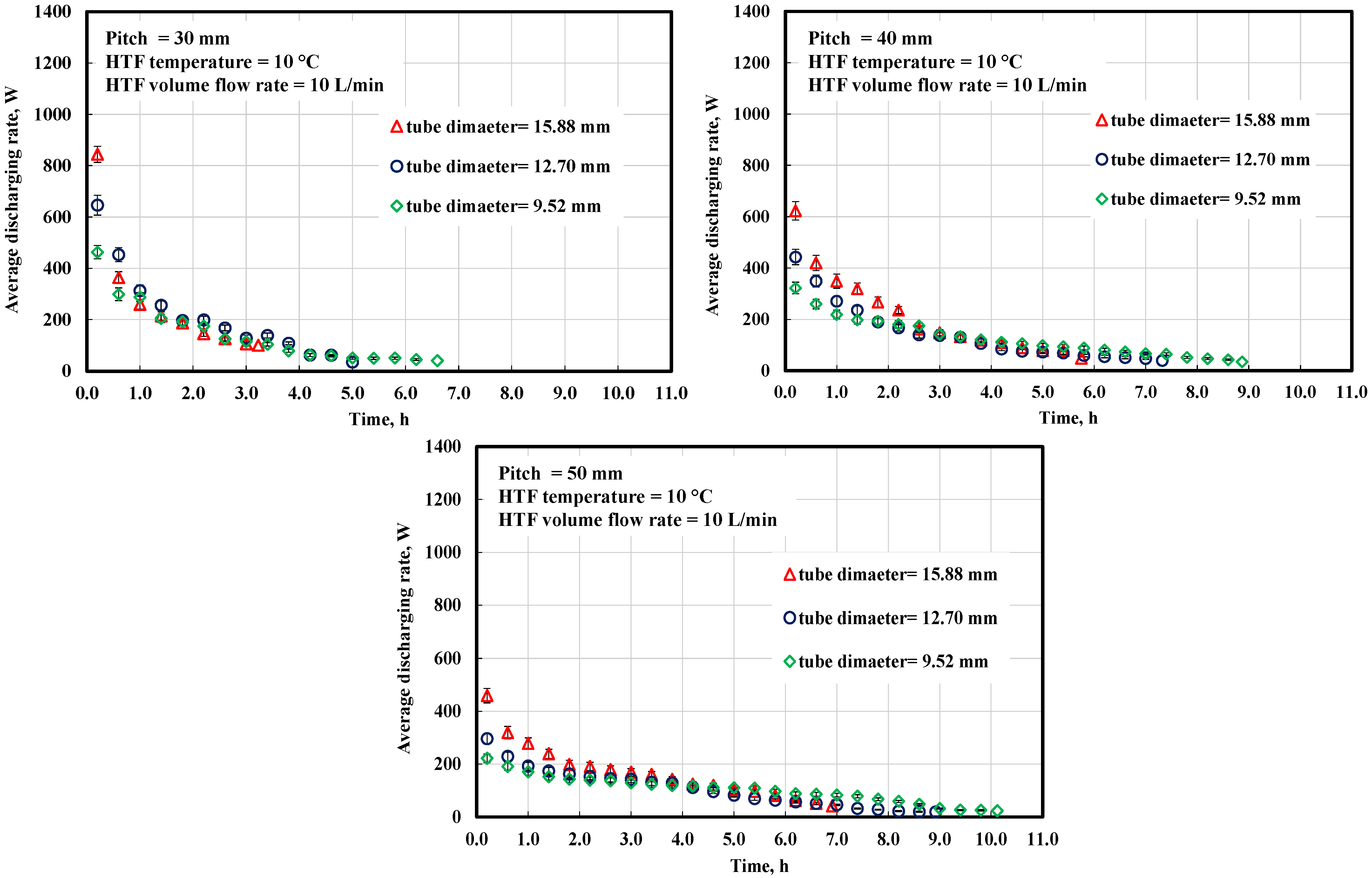
| Reference | Used Coil | Type of Study | Merits | Demerits |
|---|---|---|---|---|
| [4] | Thirty-four counter current spiral-shaped tubes | Experimental | The use of spiral-shaped coils induces centrifugal forces in the HTF, which have a stabilizing effect on the flow | Ice cracking is random but follows a specific pattern. When ice begins to crack, it floats, and the heat transfer fluid that returns from the top coils, where most of the ice is gathered, tends to diminish. In contrast, heat transfer fluid in lower coils tends to rise more quickly. |
| [8] | Thin rings and annular fins around coils | Experimental And Numerical | - Results for the case of annular fins demonstrate that the optimal operating point is calculated at a spacing of 50 mm between two neighboring fins. - The ice production would be 21% and 34% greater when annular fins and rings are used compared with the bare tube. - Most ice forms when diagonal rings are used, and more ice forms while using the tube with fins. | The effect of annular fin spacing is quantified. More fins increase the contact surface area, which speeds up heat transfer. As the number of fins grows, more phase change materials near the tube surface will be replaced by low-heat capacity fin materials, reducing the cold storage available. |
| [10] | The coil has a counterflowing staggered pipe configuration with an Archimedean spiral shape. | Experimental And Numerical | The interface measuring approach may monitor solid–liquid interface fluctuations in big, closed storage tanks. | An external melting mode may provide lower output temperatures for longer than an internal melting mode. |
| [14] | Conical coil and normal coil (Helical coil) | Experimental | - Conical coil melting rate was 28.32% higher than conventional coil at 80 °C HTF intake temperature. Conical coils store energy more quickly than normal coils. - Faster energy storage with conical coil storage compared with regular storage. - The conical coil form was suitable for heat transmission since its base is wider than its peak. | [14] |
| Item | Description |
|---|---|
| Ice storage tank | Acrylic “Insulated” Inner diameter = 250.8 mm Height = 350 mm Thickness = 6 mm |
| Twin-Centric Helical Coils (TCHC) | Geometrical parameters are described in Table 3 |
| Charging reservoir | 45 L capacity |
| Discharging reservoir | 45 L capacity |
| Charging temperature, °C | −12 |
| Discharging temperature, °C | 10 |
| HTF volume flow rate, L/min | 10 |
| Digital Temperature Controller (DTC) | Temperature control, with a set point differential of ±1 °C |
| Description | Inner Coil | Outer Coil | ||||
|---|---|---|---|---|---|---|
| Outer tube diameter (), mm | 9.52, 12.70, 15.88 | |||||
| Centerline radius (), mm | 29.76 | 92.46 | ||||
| Pitch (p), mm | 30 | 40 | 50 | 30 | 40 | 50 |
| No. of turns (N) | 6.67 | 5 | 4 | 6.67 | 5 | 4 |
| Property | Water at 0 °C | Ice at 0 °C |
|---|---|---|
| Density, kg/m3 | 1000 | 920 |
| Specific heat, J/kg.°C | 4230 | 2040 |
| Fusion latent heat, J/kg | 333.7 × 103 | |
| Parameter | |
|---|---|
| , (-) | ±2.7% |
| , (%) | ±4.1% |
| , (W) | ±8.6% |
Publisher’s Note: MDPI stays neutral with regard to jurisdictional claims in published maps and institutional affiliations. |
© 2022 by the authors. Licensee MDPI, Basel, Switzerland. This article is an open access article distributed under the terms and conditions of the Creative Commons Attribution (CC BY) license (https://creativecommons.org/licenses/by/4.0/).
Share and Cite
Refaey, H.A.; Alotaibi, A.S.A.; Abdel-Aziz, A.A.; Abd Rabbo, M.F.; Abdelrahman, H.E. Geometrical Parameter Effects on Solidification/Melting Processes Using Twin Concentric Helical Coil: Experimental Investigations. Appl. Sci. 2022, 12, 11047. https://doi.org/10.3390/app122111047
Refaey HA, Alotaibi ASA, Abdel-Aziz AA, Abd Rabbo MF, Abdelrahman HE. Geometrical Parameter Effects on Solidification/Melting Processes Using Twin Concentric Helical Coil: Experimental Investigations. Applied Sciences. 2022; 12(21):11047. https://doi.org/10.3390/app122111047
Chicago/Turabian StyleRefaey, H. A., Abdullah S. A. Alotaibi, A. A. Abdel-Aziz, M. F. Abd Rabbo, and H. E. Abdelrahman. 2022. "Geometrical Parameter Effects on Solidification/Melting Processes Using Twin Concentric Helical Coil: Experimental Investigations" Applied Sciences 12, no. 21: 11047. https://doi.org/10.3390/app122111047






